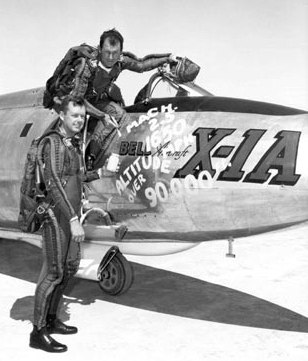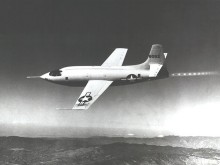Chuck Yeager - Page 2
First man to break the sound barrier, flying Bell X-1
By Stephen Sherman, Oct. 1999. Updated June 30, 2011.
Muroc Field
After WW2, Chuck Yeager was assigned to be a test pilot at Muroc Field in California.
Muroc was high up in the California desert, a barren place except for sagebrush and Joshua Trees. The main attraction of Muroc was Rogers Dry Lake, a flat expanse that was covered with a couple inches of water in the winter, and dried out hard and flat in the spring. A natural landing field, with miles of good surface in every direction. In 1946, the whole place was off-limits, a top secret Army base, developing jet and rocket planes. And there was almost nothing there - two simple hangars, some fuel pumps, one concrete runway, and a few shacks.
In many ways, Muroc was fighter pilot Heaven in the late '40s: the run-down, Quonset-hut facilities didn't attract many visits from the Army Air Force top brass, and there wasn't much to do there but fly, and drink and drive fast cars. Pancho Barnes' "Fly Inn" was the pilots' favorite watering hole.
Breaking the Sound Barrier
One of the great unknowns of the time was the so-called "sound barrier." Planes like the British Meteor jets that approached the speed of sound (760MPH at sea level, 660 MPH at 40,000 feet) had encountered severe buffeting of the controls. At that time, no one knew for sure whether an airplane could exceed "Mach 1," the speed of sound. A British pilot, Geoffrey de Havilland, had died trying. The U.S. Army was determined to find out first.
The Army had developed a small, bullet-shaped aircraft, the Bell X-1, to challenge the sound barrier. A civilian pilot, Slick Goodlin, had taken the Bell X-1 to .7 Mach, when Yeager started to fly it. He pushed the small plane up to .8, .85, and then to .9 Mach. The date of Oct. 14, 1947 was set for the attempt to do Mach 1. Only a slight problem developed. Two nights before, after an evening at Pancho's, Chuck and Glennis went out horseback riding, Chuck was thrown, and broke two ribs on his right side. He couldn't have reported this to the Army doctors; they might have given the flight to someone else. So Yeager taped up his ribs and did his best to keep up appearances. On the day of the flight, it became apparent that, with his injured right side, he wouldn't be able to shut the door of the Bell X-1. In the plane's tiny cockpit; he could only use his (useless) right hand. He confessed his problem to Ridley, the flight engineer. In a stroke of genius, Ridley sawed off a short piece of broomstick handle; using it with his left hand, Yeager was able to get enough leverage to slam the door shut.
And that day, Chuck Yeager became the first man to fly faster than the speed of sound. Tom Wolfe described the conclusion of the exhilarating flight in his splendid book, The Right Stuff:
The X-1 had gone through "the sonic wall" without so much as a bump. As the speed topped out at Mach 1.05, Yeager had the sensation of shooting straight through the top of the sky. The sky turned a deep purple and all at once the stars and the moon came out - the sun shone at the same time. ... He was simply looking out into space. ... He was master of the sky. His was a king's solitude, unique and inviolate, above the dome of the world. It would take him seven minutes to glide back down and land at Muroc. He spent the time doing victory rolls and wing-over-wing aerobatics while Roger Lake and the High Sierras spun around below.
Click here to read a review of The Right Stuff at Amazon.com.
After the flight, the Army clamped tight security on the whole thing, and Yeager couldn't tell anyone. He celebrated with just a few other pilots at Pancho's. He flew a dozen more transonic flights in the X-1, but still under tight wraps. His accomplishment wasn't announced to the public until mid-1948. The Bell X-1 is now on display at the National Air and Space Museum
After the establishment of the Air Force as a separate branch of the military, Muroc became Edwards Air Force Base.
Flight Test in the 1950's - The X-Planes
Because of his consummate piloting skill, his coolness under pressure and ability to detect a problem, quickly analyze it and take appropriate action, Yeager was selected to probe some of the most challenging unknowns of flight in aircraft such as the X-1A, X-3, X-4, X-5 and XF-92A.
Douglas D-558-II Skyrocket
The records of the X-1 were soon exceeded by the swept-wing Douglas D-558-II Skyrocket. First flown in February, 1948. Pilots such as Pete Everest, Bill Bridgeman, and Marion Carl pushed the envelope with it, achieving speeds of Mach 1.45 and 1.88. Carl took it as high as 83,000 feet. But its ultimate performance came in November, 1953, when Scott Crossfield reached Mach 2 in a shallow dive at 62,000 feet.
X-1A
Crossfield's distinction as "the fastest man alive" was short-lived. Less than a month later, Yeager piloted the rocket-powered X-1A to a record 1,650 mph (Mach 2.44) on Dec. 12, 1953. During this flight, he became the first pilot to encounter inertia coupling. The aircraft literally tumbled about all three axes as it plummeted for more than 40,000 feet before he was able to recover it to level flight. Even his rival, Scott Crossfield, has since conceded that it was "probably fortunate" that Yeager was the pilot on that flight "so we had the airplane to fly another day." Later in 1953, Kit Murray flew the X-1A up to a new record height, 90,440 feet. Only one model of the Bell X-1A existed; it was destroyed in July, 1955
X-2
As flight researchers designed aircraft that could fly at Mach 3, they encountered more problems: severe heating, instability, and worse inertial coupling. The swept-wing Bell X-2, with a 15,000 pound thrust, dual chambered rocket engine, constructed of stainless steel, was the next in the series to meet these challenges. Pete Everest made the first powered flight in the X-2 in November, 1955 and later flew it to a new speed record of Mach 2.87. In 1956 pilots Mel Apt and Iven Kincheloe (a Korean War ace) were assigned to the X-2 project. "Kinch" set a new altitude record of 126,000 feet on Sept. 7. Three weeks later Mel Apt became the first man to reach Mach 3; he encountered the same inertial coupling and tumbling as Yeager had in the X-1A, but couldn't pull out of it. Both he and the aircraft were lost.
X-3
The Douglas X-3 looked like the hottest and faster airplane ever. It still does. But looks are deceiving. Westinghouse proposed J46 turbojet engines grew too large for the X-3. To get the plane airborne, a pair of J34's were installed, but could never power the plane as intended for sustained supersonic flight test. The X-3 could only exceed Mach 1 in a steep dive. Yeager flew the X-3.
X-15
Of course, the ultimate X-plane was the X-15, a true space plane, which pilots like Bob White, Joe Engle, and Neil Armstrong took to extraordinary new records in the 1960's. Joe Walker took the X-15 to a speed of Mach 5 in 1963.
Read an article about the X-15.
By latter-day standards, it is remarkable that, while engaged in a wide range of such highly experimental flight research programs, Yeager was also involved in the evaluation of virtually all of the aircraft that were then being considered for the Air Force's operational inventory. Indeed, he averaged more than 100 flying hours per month from 1947-1954 and, at one point, actually flew 27 different types and models of aircraft within the span of a single month.
In 1953, Yeager tested the Russian MiG-15, serial #2057, that a North Korean pilot had defected with. (Click on the link to read about Lt. Kum Sok No's dramatic defection on September 21, 1953.)
Command
Through the 1950's and 60's, Yeager continued his successful career as a United States Air Force officer and test pilot.
In October 1954, he was assigned to command the 417th Fighter Squadron, first in Germany and then in France. Returning to the United States in September 1957, he served as commander of the 1st Fighter Squadron at George Air Force Base, Calif.
While he did not enter the astronaut program with John Glenn and the other Mercury Seven, he was appointed director of the Aerospace Research Pilot School (ARPS) at Edwards Air Force Base.
One of the planes he tested in 1963 was the NF-104, an F-104 with a rocket over the tailpipe, an airplane which theoretically could climb to over 120,000 feet. Yeager made the first three flights of the NF-104. On the fourth, he planned to exceed the magic 100,000 foot level. He cut in the rocket boosters at 60,000 feet and it roared upwards. He gets up to 104,000 feet before trouble set in. The NF-104's nose wouldn't go down. It went into a flat spin and tumbled down uncontrollably. At 21,000 feet, Yeager desperately popped the tail parachute rig, which briefly righted the attitude of the plane. But the nose promptly rose back up and the NF-104 began spinning again. It was hopeless. At 7,000 feet Yeager ejected. He got tangled up with his seat and leftover rocket fuel, which burnt him horribly. He hit the ground in great pain and his face blackened and burned, but standing upright with his chute rolled up and his helmet in his arm when the rescue helicopter arrived.
This scene was dramatically presented toward the end of the movie, The Right Stuff, and some have conflated this scene with Yeager breaking the sound barrier in the X-1.
He went to Vietnam as commander of the 405th Fighter Wing in 1966 and flew 127 combat missions, and eventually rose to the rank of Brigadier General.
In February 1968, he took command of the 4th Tactical Fighter Wing at Seymour Johnson Air Force Base, N.C., and in February 1968, led its deployment to Korea during the Pueblo crisis. In July 1969, he became vice commander of the 17th Air Force, at Ramstein Air Base, Germany, and then, in January 1971, he was assigned as U.S. defense representative to Pakistan. On June 1, 1973, he commenced his final active duty assignment as director of the AF Safety and Inspection Center at Norton Air Force Base, Calif. After a 34-year military career, he retired on March 1, 1975. At the time of his retirement, he had flown more than 10,000 hours in more than 330 different types and models of aircraft.
In 1986, Yeager was appointed to the Presidential Commission investigating the Challenger accident.
Sources and Links
Edwards AFB - well-designed, easy to navigate site, good use of Flash on main page, lots of history on test pilots, airplanes, and Edwards/Muroc





